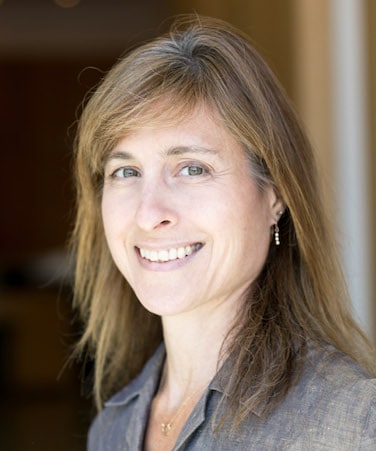- Associate Professor, Environmental Sciences Initiative
- Associate Professor of Earth and Environmental Sciences, Queens College
Dianne Greenfield, Ph.D.
Phytoplankton, microscopic organisms that form the base of aquatic food webs, generate approximately half of the world’s oxygen through photosynthesis and thus exert considerable influence over nutrient and carbon cycling.
Dr. Dianne Greenfield and her laboratory study the complex environmental feedbacks between global change stressors (such as urbanization, nutrients, and climate) and coastal phytoplankton ecology, physiology, and biogeochemistry. This includes but is not limited to understanding the causes and consequences of ‘harmful algal blooms’ (HABs), events produced by a subset of phytoplankton species that result in negative ecological and/or health impacts when populations become numerically or physiologically dominant.
To achieve this goal, Greenfield and her lab develop and apply novel molecular tools to better study plankton populations in situ and combine these advances with traditional field and laboratory approaches. Since phytoplankton dynamics are central to ecosystem productivity, Greenfield and her lab also try to understand their linkages with coastal trophic structure.
Dr. Greenfield joined the Advanced Science Research Center at the Graduate Center during fall of 2017; she also is an Associate Professor in the School of Earth and Environmental Sciences, Queens College. Prior to that time, Greenfield was in Charleston, SC with the Belle W. Baruch Institute for Marine and Coastal Sciences, University of South Carolina with a joint appointment at the Marine Resources Research Institute (SCDNR).
In 2018, Dr. Greenfield was elected to the position of Secretary for the Association for the Sciences of Limnology and Oceanography (ASLO), and serves as CUNY’s representative for the Long Island Sound Study (LISS), Science and Technical Advisory Committee (STAC).
Dr. Greenfield completed her BA from Mount Holyoke College, MS from Tulane University, PhD from Stony Brook University, and a Postdoctoral Fellowship from the Monterey Bay Aquarium Research Institute (MBARI).
Prof. Greenfield is actively searching for talented and enthusiastic students and researchers to join her team. Please contact her at dgreenfield@gc.cuny.edu orDGreenfield@qc.cuny.edu if you have further questions.
Google Scholar Citations: https://scholar.google.com/citations?hl=en&user=BjBN2VkAAAAJ
Publications
| Title |
|---|
D.I. Greenfield and K.J. Coyne. Comparison of two molecular methods, Quantitative Polymerase Chain Reaction and Sandwich Hybridization Assay, for monitoring the Harmful Algal Bloom species, Heterosigma akashiwo. Environmental Management, 2025, 75, 1589-1601. |
G.E. Humphries, M. Ambrosone, Z. Roldan-Ayala, M. Brown, and D.I. Greenfield. Shore and mid-channel surveys reveal distinct phytoplankton-bacterial population associations along an urban estuary. Aquatic Microbial Ecology, 2024, 90, 121-139.
|
M. Brown, M. Ambrosone, K.J. Turner, K.J., G. Humphries, M. Tzortziou, S. Anglès, C. Panzeca, C. and D.I. Greenfield. Phytoplankton assemblage responses to nitrogen following COVID-19 stay-in-place orders in western Long Island Sound (New York/Connecticut). Marine Environmental Research, 2024, 196, 106371. |
Z. Roldan Ayala, S.A. Arnott, M. Ambrosone, J.I. Espinosa, G.E. Humphries, M. Tzortziou, J. I. Goes, and D.I. Greenfield. The influences of phenology, spatial distribution, and nitrogen form on Long Island Sound phytoplankton biomass and taxonomic composition. Estuarine, Coastal and Shelf Science, 2023, 292, 108451. |
J. Sherman, M. Tzortziou, K.J. Turner, D.I. Greenfield, and A. Menendez. Deciphering the water quality impacts of COVID-19 human mobility shifts in estuaries surrounding New York City. Science of the Total Environment, 2023, 896, 164953. |
Z.R. Ayala, S.C. Judge, S. Anglès, and D.I. Greenfield. A comparison between the FlowCam 8100, microscopy, and sandwich hybridization assay for quantifying abundances of the saxitoxin-producing dinoflagellate, Alexandrium catenella. Harmful Algae, 2023, 125, 102423. |
G.E. Humphries, J.I. Espinosa, M. Ambrosone, Z. Roldan Ayala, M. Tzortziou, J.I. Goes, D.I. Greenfield. Transitions in nitrogen and organic matter form and concentration correspond to bacterial population dynamics in a hypoxic urban estuary. Biogeochemistry, 2023, 163, 219-243. |
N.A. Alcantar, S. Banta, A.D. Cak, X. Chen, C. DelRe, L.F. Deravi, J.S. Dordick, B.M. Giebel, D. Greenfield, P.M. Groffman, M. Holford, G. John, N.S. Joshi, N.A. Kotov, J. K. Montclare, B.S. Moore, J.H. Ortony, A.B. Reinmann, J. Son, R.E. Stark, R.V. Ulijn, C.J. Vörösmarty, C.J. Wilson, Bioinspired Green Science and Technology Symposium in NYC, Matter, 2022, 5, 7, 1980-1984. |
N.M. Dearth, W.J. Jones, J. Espinosa, R.A. Mortensen, J.L. Pinckney, and D.I. Greenfield. A new sandwich hybridization assay method to identify and quantify Microcystis spp. Limnology and Oceanography: Methods, 2022, 20, 4, 210-221. |
L.F. Santoferrara, G.B. McManus, D.I. Greenfield, and S.A. Smith. Microbial communities (bacteria, archaea and eukaryotes) in a temperate estuary during seasonal hypoxia. Aquatic Microbial Ecology, 2022, 88, 61-79. |
D.I. Greenfield, E.M. Smith, A.M. Tweel, D.M.Sanger, and K.A. Sitta. The Ecological Function of South Carolina Stormwater Ponds within the Coastal Landscape. In Stormwater Ponds in Coastal South Carolina: 2019 State of the Knowledge Full Report. Cotti-Rausch B.E., Majidzadeh, J., Devoe, M.R., Eds. South Carolina Sea Grant Consortium, 2019. pp 83-104. |
E. Van Meerssche, D.I. Greenfield, and J.L. Pinckney. Coastal Eutrophication and Freshening: Impacts on Pseudo-nitzschia Abundance and Domoic Acid Allelopathy. Estuarine, Coastal, and Shelf Science, 2018, 209, 70-79. |
K.A. Sitta, M. Reed, R. Mortensen, C. Doll, T. Callahan, and D.I. Greenfield. The Influences of Nitrogen Form and Zooplankton Grazing on Phytoplankton Assemblages in Two Coastal Southeastern Systems. Limnology and Oceanography, 2018, 63, 2523-2544. |
C. Main, D.I. Greenfield, C. Doll, Y. Wang, R. Mortensen, E.B. Whereat, D.T. Pettay, and K.C. Coyne. Critical comparison of molecular methods for detection and enumeration of the harmful algal species, Heterosigma akashiwo, in environmental water samples. Journal of Applied Phycology, 2018, 30, 2425-2434. |
J.L. Pinckney, C. Tomas, D.I. Greenfield, K. Reale-Munroe, B. Castillo, Z. Hillis-Starr, E. Van Meerssche, and M. Zimberlin. Seasonal Changes in Phytoplankton Community Structure in a Bioluminescent Lagoon, St. Croix, US Virgin Islands. Aquatic Microbial Ecology, 2018, 81, 109-124. |
K.K. Ellis, T. Callahan, D.I. Greenfield, D.M. Sanger, and J. Robinson. Measuring and Modeling Flow Rates in Tidal Creeks: A Case Study from the Central Coast of South Carolina. Journal of South Carolina Water Resources, 2017, 4, 1, 21-39. |

